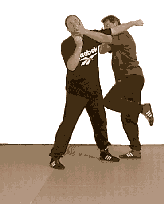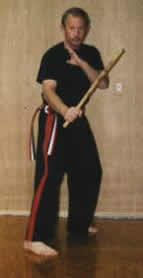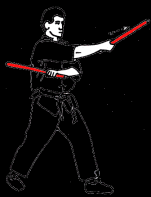|
|
Eskrima (Doce Pares)
|
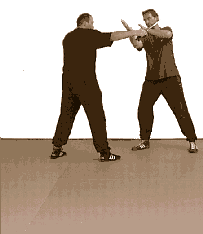
|
|
ESKRIMA IN THE PHILIPPINES & Grandmasters : In the past, challenge matches called ‘Juego Todo’ were very common in the Philippines. No holds barred and without he aid of protective equipment, the winner was determined either by submission or death. Anyone claiming to be an expert in Eskrima was fair game and could be challenged to engage in Juego Todo. However, this practice has now been outlawed and traditional challenges are now a rare occurrence. Fear of being challenged to defend one’s claim, had in the past, protected the art from being exploited. Unfortunately, today there is little to prevent lesser exponents from claiming to be Masters in the deadly Art of Eskrima. So many people are now available to teach that locating a genuinely qualified Instructor in the Philippines today is not an easy task; finding a really good one is extremely difficult. To the new student with a desire to learn, investing time and money in a teacher can therefore be something of a risk. The realisation later that nothing of any real value has been learnt can be so demoralising that they conclude their practice of the art. Therefore, in order to preserve the true art of Eskrima some of the great Masters are now coming out into the open. An organisation under the title Institute of Philippine Martial Arts (IPMA) has recently been incorporated in Cebu City. Founded by one of Eskrima’s leading exponents - Grandmaster Abner Pasa, the Institute aims to act as an intermediary through which visiting Eskrimadors from all over the world can gain access to legitimate Masters. A typical training routine with Grandmaster starts with an early morning programme of physical activities designed to develop flexibility, endurance and strength. Essential skills such as grips and the execution of strikes are drilled until they are performed naturally. The premise of his training methodology is that all technique is basically the acquisition and development of motor skills. The repetition of drills and exercises is designed to develop muscle memory so that the appropriate response to any situation is smooth, fluid and almost instantaneous. The lessons are realistic and straight forward, simple but deadly. On one occasion when playing double dagger (‘playing in Filipino means sparring), I asked Grandmaster what he wanted me to do. In a very casual manner he replied, "I am your enemy. Do you really expect me to answer that question?" I almost burst out laughing with the realisation that my attitude in this particular instance was not appropriate. His training approach when sparring the knife is to simulate the stress of a live-threatening situation, using one’s imagination to arouse the survival instinct. "How long it takes to be classed as an ‘expert’
in Eskrima - how do you determine who is ahead or who is better than the
other ?" Traditionally, the ultimate test of one’s skills in Eskrima has been having the ability to avoid being hit. In the past, the favourable attraction during Fiesta celebrations was for a local expert in the art to challenge one and all to a friendly match. The object was for the Eskrimador to defend and counterstrike without being struck or losing his balance. Such was the skill that, often when even balanced on a triangle of coconut halves, he rarely lost. 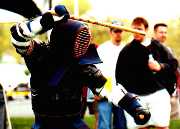 
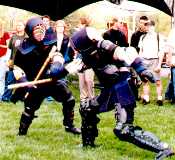 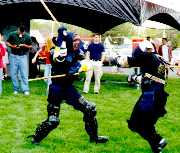

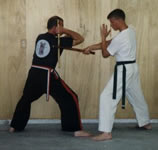
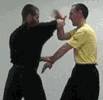
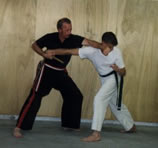
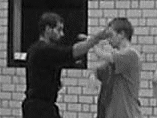
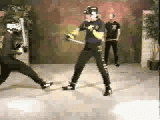
Espada y daga and olisi y baraw (sword and knife) : "Espada y daga" (sword and knife) area of training is often viewed by many as being "classical" and somewhat redundant in today's civilised society. Afterall how many of us carry a sword and dagger around? The purpose of this article is to try and explain why we still train in this method, what attributes it develops and it's relationship with olisi y baraw (stick and knife). In much the same way as Judo stems from Ju Jitsu, olisi y baraw has it's roots in espada y daga. When the Spanish imposed a ban on the practice of all native fighting arts and the carrying of bladed weapons during their occupation of the islands, the Filipinos were forced to substitute the use of the sword with that of rattan. In the beginning the rattan was used to deliver strikes in the same manner as the blade i.e. slashing and thrusting, and the knife (or short stick) was still held in reserve as a back up weapon in case the opponent managed to close the distance, typical of it's use by the Spanish. Hardly ever was it used to block or parry an oncoming strike. However through time the Filipinos began to realise that because the stick had different handling qualities, certain lines of attack were open to them that were not available with the sword e.g. curved and snapping strikes. Once they began to appreciate the combat effectiveness of the stick the use of the knife also changed and began to be used more aggressively in terms of blocking, parrying, checking, scooping, thrusting and slashing. Olisi y baraw had been born. Although olisi y baraw translates as "stick and knife" and is commonly used in the practice of espada y daga to simulate the sword, each method is quite separate from the other and therefore the application of their techniques different too. One of the primary differences is that of range. Whilst espada y daga is fought mainly at middle and long range because of the use of the sword, olisi y baraw affords the practitioner the opportunity to fight at long, middle and close range. "The design of the weapon dictate its use." Not to mention the environment in which it's used. I think it would be more accurate to say that as in any art it is certain concepts and universal principles that are interchangeable as opposed to techniques. A good example of this can be found when we consider grappling. Think of the multitude of systems that practice locking. There are countless variations of wrist locks, elbow locks, shoulder locks, neck, leg and foot locks, but at the end of the day a lock is a lock and without going into an analysis about what makes a lock work, it's enough to say that the principles used in applying them remain constant no matter what art you practice or how you get into it. "What are the benefits of training in espada y daga" ? , the most apparent is an appreciation of distance, especially at long and close range. It also enables the practitioner to better understand where the safer positions are through zoning to the outside of an attack. At the same time he has to be aware that in the process of angling off, if not done properly there's the possibility he will allow his opponent to "load up" with his rear hand or weapon. This can be likened to inadequately slipping a jab to the outside only to get caught with the cross. Along with learning to use the weaker hand to defend, scoop (unbalancing techniques used to upset an opponent's structure) and attack, it also teaches you never to commit two hands to one attack. While this may seem obvious with regards to empty hands, it's not so obvious when dealing with weapons. If one is defending the other is always ready to attack, and like wise if one is attacking the other is always prepared to defend. As with most arts you have to look beyond the aesthetic wrapping to see and appreciate what they have to offer. Invariably this requires a degree of patience and open mindedness. Far from being "redundant" exercises, espada y daga and olisi y baraw are two such arts. |
||
